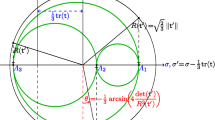Abstract
The objective of this paper is to show the significance of expressing the strain energy function in terms of a scalar pure measure of dilatation and a tensor pure measure of distortion, which were essentially introduced by Flory [1]. It is shown that convenient representations for the strain energies of dilatation and distortion, and the pressure and deviatoric Cauchy stress may be recorded in terms of these deformation measures. After specializing to the case of an isotropic material, specific constitutive equations are proposed and the Poynting problem is considered. It is shown that the Poynting effect (extension of a bar in torsion) is significantly influenced by coupling between dilatational and distortional strain energies, which is caused by the dependence of the shear modulus on dilatation.
Similar content being viewed by others
References
P.J. Flory: Thermodynamic relations for high elastic materials, Trans. Faraday Soc. 57 (1961) 829–838.
R.W. Ogden: Nearly isotropic elastic deformations: application to rubberlike solids, J. Mech. Phys. Solids 26 (1978) 37–57.
R.S. Rivlin and D.W. Saunders: Large elastic deformations of isotropic materials VII: experiments on the deformation of rubber, Phil. Trans. R. Soc. Lond. A 243 (1951) 251–288.
Y. Partom: The dilatational and distortional partition of the energy function in finite strain, Israel J. of Tech. 4 (3) (1966) 218–223.
J.H. Poynting: On pressure perpendicular to the shear planes in finite pure shears, and on the lengthening of loaded wires when twisted, Proc. R. Soc. Lond. A 82 (1909) 546–559.
J.H. Poynting: On the changes in the dimensions of a steel wire when twisted, and on the pressure of distortional waves in steel, Proc. R. Soc. Lond. 86 (1912) 534–561.
M.F. Beatty: A class of universal relations in isotropic elasticity theory, J. Elasticity 17 (1987) 113–121.
M.B. Rubin: An elastic-viscoplastic model for metals subjected to high compression, J. Appl. Mech. 54 (1987) 532–538.
H.W. Swift: Length changes in metals under torsional overstrain, Engineering 163 (1947) 253–257.
F.D. Murnaghan: Finite Deformation of an Elastic Solid, John Wiley and Sons, New York (1951) p. 68.
Author information
Authors and Affiliations
Rights and permissions
About this article
Cite this article
Rubin, M.B. The significance of pure measures of distortion in nonlinear elasticity with reference to the Poynting problem. J Elasticity 20, 53–64 (1988). https://doi.org/10.1007/BF00042140
Received:
Accepted:
Issue Date:
DOI: https://doi.org/10.1007/BF00042140




